Map: Where has monkeypox been detected so far?
At least 16,836 confirmed cases and five deaths have been reported from at least 74 countries or territories since the start of 2022.
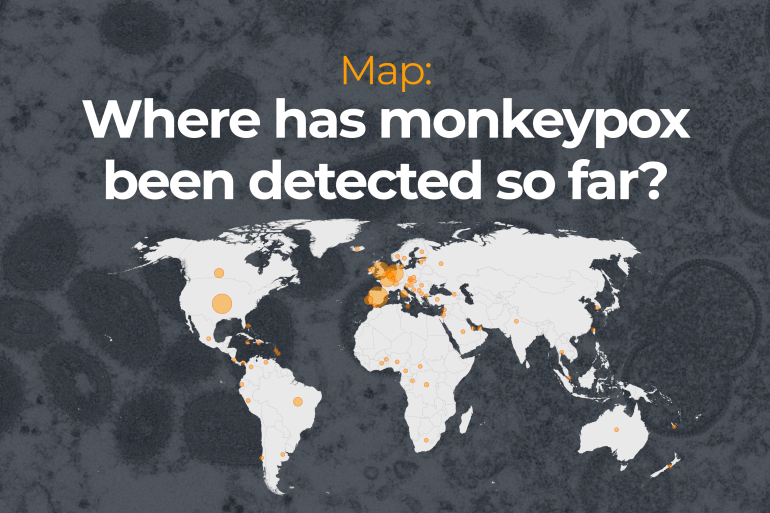
The World Health Organization (WHO) has declared monkeypox a “public health emergency of international concern”.
The WHO label is designed to sound an alarm that a coordinated international response is needed and could unlock funding and global efforts to collaborate on sharing vaccines and treatments.
Keep reading
list of 4 itemsIsrael, Switzerland report first monkeypox cases as virus spreads
‘Urgency’: WHO expects more monkeypox cases globally
Denmark, Scotland detect first monkeypox virus cases
At least 16,836 confirmed cases and five deaths have been reported from 74 countries or territories since the start of 2022.
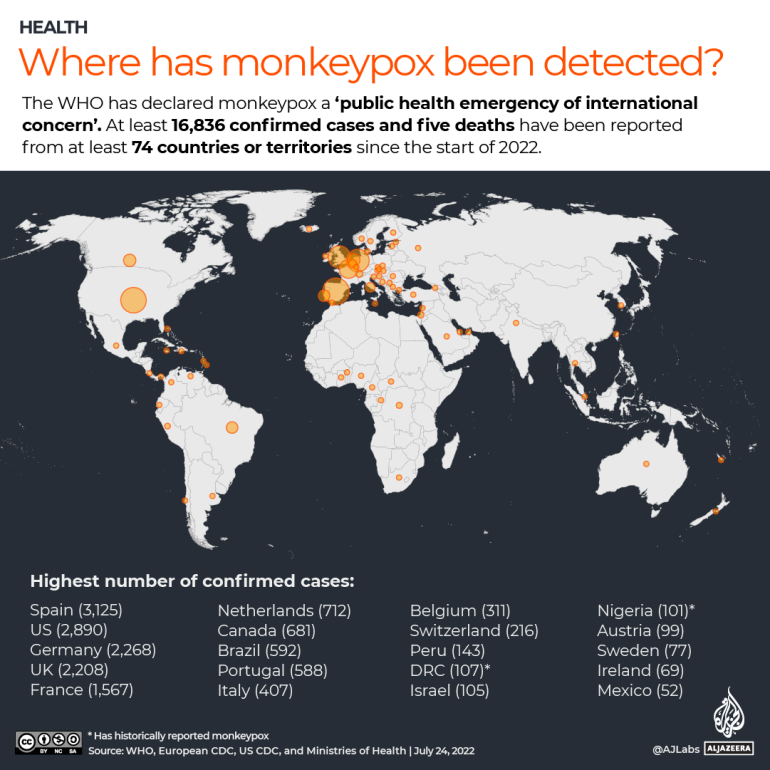
Spain (3,125), US (2,890), Germany (2,268), UK (2,208), France (1,567), Netherlands (712), Canada (681), Brazil (592), Portugal (588), Italy (407), Belgium (311), Switzerland (216), Peru (143), DRC (107), Israel (105), Nigeria (101), Austria (99), Sweden (77), Ireland (69), Mexico (52), Denmark (51), Norway (46), Australia (42), Poland (40), Hungary (33), Slovenia (27), Chile (20), Greece (20), Ghana (19), Romania (19), Argentina (18), Malta (17), Czech Republic (15), Luxembourg (14), Finland (13), UAE (13), Colombia (10), Iceland (9), CAR (8), Croatia (8), Cameroon (6), Singapore (6), Gibraltar (5), Serbia (5), Estonia (4), Lebanon (4), Benin (3), Bulgaria (3), Dominican Republic (3), Latvia (3), Slovakia (3), South Africa (3), Ecuador (2), India (2), New Zealand (2), Congo (2), Saudi Arabia (2), Taiwan (2), Bahamas (1), Barbados (1), Bosnia and Herzegovina (1), Costa Rica (1), Georgia (1), Jamaica (1), Martinique (1), Morocco (1), New Caledonia (1), Panama (1), Qatar (1), Russia (1), South Korea (1), Thailand (1), Turkey (1) and Venezuela (1).
What is monkeypox and what are its symptoms?
Monkeypox is a usually mild virus that causes fever as well as a bumpy rash. It is mostly transmitted to people from wild animals but human transmission is also possible.
Human monkeypox was first identified in humans in 1970 in the Democratic Republic of the Congo (DRC). It is called monkeypox because it was first identified in colonies of monkeys that were kept for research in 1958.
The virus is most common in remote parts of Central and West Africa.
According to WHO, symptoms of monkeypox typically include:
- fever
- intense headache
- muscle aches
- back pain
- low energy
- swollen lymph nodes
- rash or lesions
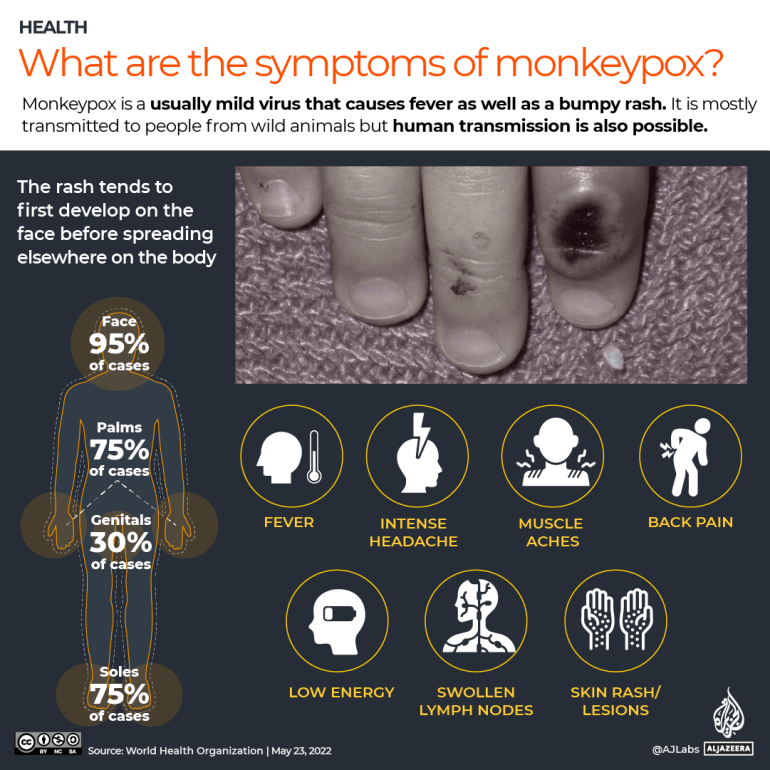
The rash tends to first develop on the face before spreading elsewhere on the body, including on the soles of feet and palms of hands. They can also be found on the mouth, genitals and eyes.
Symptoms typically last between two to four weeks, with most people recovering from the illness without treatment. Newborns, children and people with underlying immune deficiencies may be at risk of more serious symptoms and death from monkeypox.
The case death ratio of monkeypox has historically ranged from 0 to 11 percent in the general population and has been higher among young children. In recent times, the case death ratio has been approximately 3 to 6 percent.
How does monkeypox spread?
Monkeypox is transmitted to humans through close contact with an infected person or animal, or with material contaminated with the virus.
Monkeypox can spread from one person to another through close physical contact, including sexual contact.
The rash, bodily fluids and scabs are particularly infectious. Clothing, bedding, towels or objects like eating utensils that have been contaminated with the virus from contact with an infected person can also infect others.
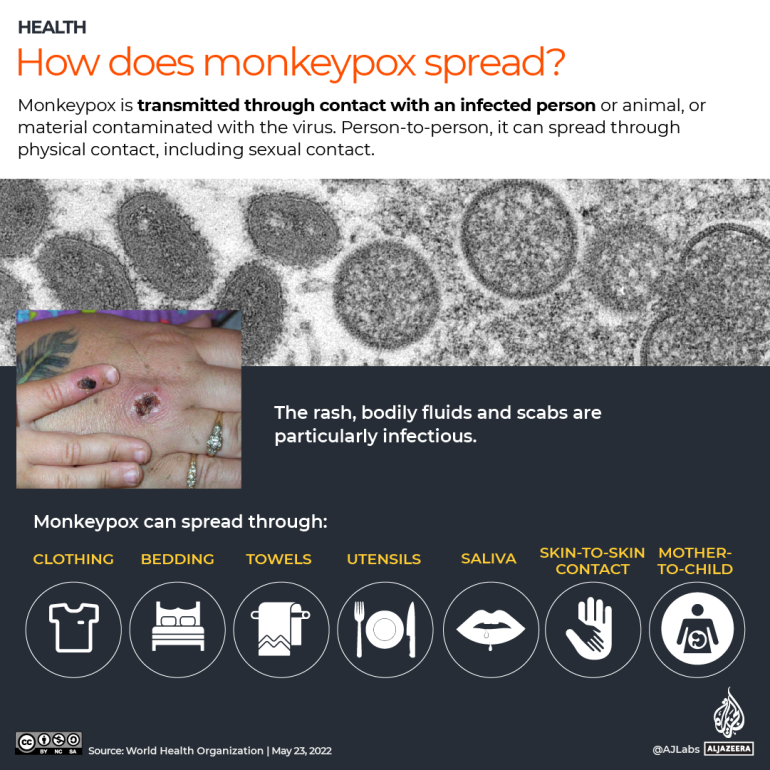
Ulcers, lesions or sores in the mouth can also be infectious, meaning the virus can spread through saliva. People who closely interact with someone who is infected, including health workers, household members and sexual partners, are therefore at greater risk for infection.
The virus can also spread from someone who is pregnant to their fetus, or from an infected parent to a child during or after birth through skin-to-skin contact.
It is not clear whether infected people whose symptoms are not showing yet can spread the disease.
Monkeypox treatment
In most cases, monkeypox symptoms resolve on their own without the need for treatment.
For those who are infected, it is important to take care of the rash or sores by letting them dry out if possible or covering them with a dressing to protect the area. Both infected and uninfected people should avoid touching any sores.
Mouth rinses and eye drops can be used as long as cortisone-containing products are avoided. Vaccinia immune globulin (VIG) may be recommended for severe cases. An antiviral, known as tecovirimat or TPOXX, can also be used to treat monkeypox.
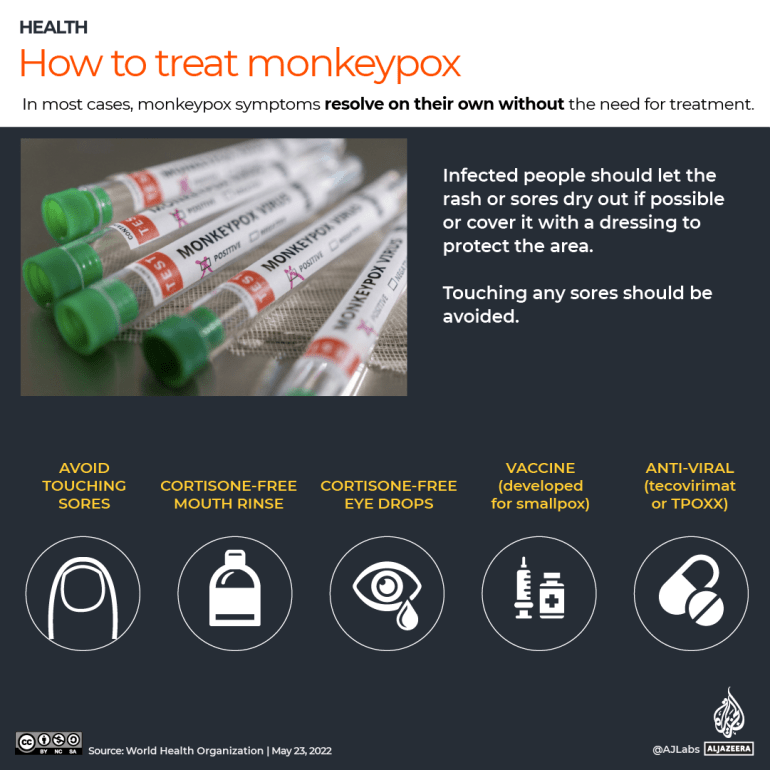
Although it causes a less serious illness, monkeypox is in the same family as smallpox.
People who were vaccinated against smallpox are likely to have some protection against monkeypox infection. However, younger people are unlikely to have been vaccinated against smallpox because smallpox vaccination stopped worldwide after the infectious disease was globally eradicated in 1980.
There are several vaccines available for the prevention of smallpox that also provide some protection against monkeypox.
In 2019, a newer vaccine – MVA-BN, also known as Imvamune, Imvanex or Jynneos – was approved for use against smallpox although it is not yet widely available.